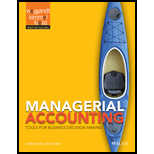
Decision-Making Across the Organization
Aurora Company is considering the purchase of a new machine. The invoice price of the machine a $140,000, freight charges are estimated to be $4,000, and installation costs are expected to be $6,000. Salvage value of the new equipment is expected to be zero after a useful life of 5 years. Existing equipment could be retained and used for an additional 5 years if the new machine is not purchased. At that time, the salvage value of the equipment would be zero. If the new machine is purchased now, the existing machine would have to be scrapped. Auroras accountant, Lisah Huang, has accumulated the following data regarding annual sales and expenses with and without the new machine.
1. Without the new machine. Aurora car sell 12,000 units of product annually at a per unit selling price of $100. If the new machine is purchased, the number of units produced and sold would increase by 10%, and the selling price would remain the same.
2. The new machine is faster than the old machine, and it is more efficient in its usage of materials. With the old machine the gross profit rate will be 25% of sales, whereas the rate will be 30% of sales with the new machine.
3. Annual selling expenses are $180,000 with the current equipment. Because the new equipment would produce a greater number of units to be sold, annual selling expenses are expected to increase by 10% if it is purchased.
4. Annual administrative expenses are expected to be $100,000 with the old machine, and $113,000 with the new machine.
5. The current book value of the existing machine is $36,000. Aurora uses straight-line depreciation.
Instructions
With the class divided into groups, prepare an incremental analysis for the 5 years showing whether Aurora should keep the existing machine or buy the new machine. (Ignore income tax effects.)
Want to see the full answer?
Check out a sample textbook solution
Chapter 7 Solutions
Managerial Accounting: Tools for Business Decision Making
- Financial Accounting Questionarrow_forwardOn July 31, Harrison Company had an Accounts Receivable balance of $25,400. During the month of August, total credits to Accounts Receivable were $68,000 from customer payments. The August 31 Accounts Receivable balance was $18,500. What was the amount of credit sales during August? A) $68,000 B) $39,100 C) $61,100 D) $75,900 E) $7,900 helparrow_forwardQuick answer of this accounting questionsarrow_forward
- Tell me correct solutionsarrow_forwardNonearrow_forwardOn July 31, Harrison Company had an Accounts Receivable balance of $25,400. During the month of August, total credits to Accounts Receivable were $68,000 from customer payments. The August 31 Accounts Receivable balance was $18,500. What was the amount of credit sales during August? A) $68,000 B) $39,100 C) $61,100 D) $75,900 E) $7,900arrow_forward
- Accountingarrow_forwardA company can sell all the units it can produce of either Product X or Product Y but not both. Product X has a unit contribution margin of $18 and takes four machine hours to make, while Product Y has a unit contribution margin of $25 and takes five machine hours to make. If there are 6,000 machine hours available to manufacture a product, income will be: A. $6,000 more if Product X is made B. $6,000 less if Product Y is made C. $6,000 less if Product X is made D. the same if either product is made. Helparrow_forwardWhat is the average collection period of this financial accounting question?arrow_forward
 EBK CONTEMPORARY FINANCIAL MANAGEMENTFinanceISBN:9781337514835Author:MOYERPublisher:CENGAGE LEARNING - CONSIGNMENT
EBK CONTEMPORARY FINANCIAL MANAGEMENTFinanceISBN:9781337514835Author:MOYERPublisher:CENGAGE LEARNING - CONSIGNMENT Fundamentals Of Financial Management, Concise Edi...FinanceISBN:9781337902571Author:Eugene F. Brigham, Joel F. HoustonPublisher:Cengage Learning
Fundamentals Of Financial Management, Concise Edi...FinanceISBN:9781337902571Author:Eugene F. Brigham, Joel F. HoustonPublisher:Cengage Learning Intermediate Financial Management (MindTap Course...FinanceISBN:9781337395083Author:Eugene F. Brigham, Phillip R. DavesPublisher:Cengage Learning
Intermediate Financial Management (MindTap Course...FinanceISBN:9781337395083Author:Eugene F. Brigham, Phillip R. DavesPublisher:Cengage Learning Financial Accounting: The Impact on Decision Make...AccountingISBN:9781305654174Author:Gary A. Porter, Curtis L. NortonPublisher:Cengage Learning
Financial Accounting: The Impact on Decision Make...AccountingISBN:9781305654174Author:Gary A. Porter, Curtis L. NortonPublisher:Cengage Learning Excel Applications for Accounting PrinciplesAccountingISBN:9781111581565Author:Gaylord N. SmithPublisher:Cengage Learning
Excel Applications for Accounting PrinciplesAccountingISBN:9781111581565Author:Gaylord N. SmithPublisher:Cengage Learning Cornerstones of Cost Management (Cornerstones Ser...AccountingISBN:9781305970663Author:Don R. Hansen, Maryanne M. MowenPublisher:Cengage Learning
Cornerstones of Cost Management (Cornerstones Ser...AccountingISBN:9781305970663Author:Don R. Hansen, Maryanne M. MowenPublisher:Cengage Learning





